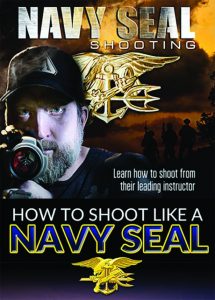Review by Joseph P. Tartaro | Executive Editor
 NAVY SEAL SHOOTING, by Chris Sajnog. ©2015. Published by Center Mass Group; 9921 Carmel Mountain Rd., Suite 556, San Diego, CA 92129; online: catermassgroup.com. Large soft cover, 365 pages with many illustrations and diagrams. List price: $29.97. Available at storefront and online booksellers.
NAVY SEAL SHOOTING, by Chris Sajnog. ©2015. Published by Center Mass Group; 9921 Carmel Mountain Rd., Suite 556, San Diego, CA 92129; online: catermassgroup.com. Large soft cover, 365 pages with many illustrations and diagrams. List price: $29.97. Available at storefront and online booksellers.
The very idea that you can learn how to shoot effectively from a book may strike many readers as an improbability. But then, Navy SEAL Shooting isn’t just a book, and it’s not just by any writer.
This is a “How-To” manual by the SEAL’s leading firearms instructor: Chris Sajnog, who’s not only been there and done that but has taught others to do likewise and come back to tell about it.
As the Foreword by Scott McEwen, best-selling co-author of American Sniper points out, “when our country needed someone to write the instruction manual for the elite US Navy SEAL Team Sniper program, they looked to one man—Chief Petty Officer Chris Sajnog.”
A quick examine of Navy SEAL Shooting will give you an idea why, but the whole book deserves a lot of study. It’s not just a simple examination of the mechanics of shooting, and it does cover pistol, rifle and shotgun. It examines everything to do with shooting excellence.
Of course there is a lot of emphasis on the fundamentals of shooting, which Sajnog stresses; you must practice improving to the point where you are absolutely perfect. But it goes beyond that to stress motivation, lifestyle, nutrition and objectives. Above all, the author stresses that each training session must produce results that provide measureable improvement, improvement that you should keep record of in a notebook.
But not all of the training is limited to the shooting range. Sajnog places a lot of emphasis on dry-firing to the point where you can develop the “habit of perfection” when it comes to the essential fundaments of shooting. He recommends dry-fire practice frequently at any safe time and in any safe place.
Navy SEAL shooting is divided into four basic sections after an introduction, safety guidelines, and the crucial fundamentals.
They core sections are: Training, Mindset, Marksmanship and Operations. Then each section is further divided into a number of sub-chapters, each of which explained and builds toward the next level.
The chapters are appropriately illustrated so that the reader can follow the instructor’s directions in detail step by step with options provided for different conditions. If you train with a partner, they will be able to compare your body positions to those provided in the illustrations. If you train alone, you’ll probably want a mirror, so you can see how you match up to the detailed photos, some of which will illustrated not just traditional sitting, kneeling or prone positions, but behind cover and even lying on your back.
But, however you train, if you follow the training regimens of the Navy’s storied SEAL Team, you’ll learn to shoot better and build confidence in yourself, your weapon choices, and your shooting skills.
In short, by training diligently and regularly and relying and practicing what Sajnog says, you will get the same kind of instruction that the SEALs get. And that’s pretty good.



